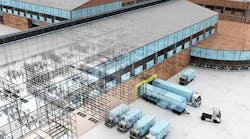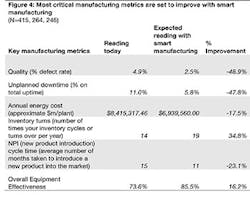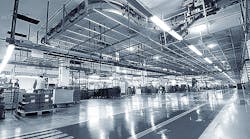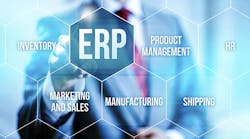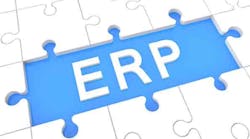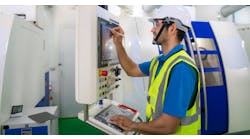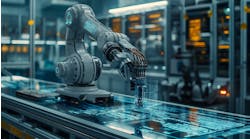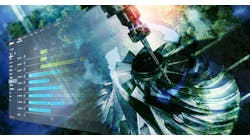Defining the Digital Enterprise, Modernizing Your Manufacturing Operations
With so many definitions being offered for “the factory of the future,” and so many components at work in a digital enterprise, how does a manager know if his organization is on the right track, or close to the goals, or already operating as a fully integrated digital enterprise? Do you know if your operation can claim the title of Smart Factory?
Characteristics of manufacturers successfully deploying digital technologies vary greatly, indicating there is room for individual operations to put a "personal" spin on their strategies and tailor applications to their market.
A common characteristic, though, is the fully integrated, holistic approach that seems to be prevalent in success digital enterprises or smart factories. "Think big" seems to be a common strategy, as manufacturers apply digital strategies across the entire value chain, and with internal and external stakeholders.
In Seven Traits of an Effective Digital Enterprise, three McKinsey analysts noted that a customer-center strategy is frequently the heart of digital initiatives: “A healthy obsession with improving the customer experience is the foundation of any digital transformation," they explained.
“No enterprise is perfect, but leadership teams should aspire to fix every error or bad experience," Olanrewaju, Smaje, and Willmott continued. “Processes that enable companies to capture and learn from every customer interaction—positive or negative—help them regularly to test assumptions about how customers are using digital and constantly fine-tune the experience.”
Although there are no governing mandates or official checklists to define the Factory of the Future, there are some common characteristics of these companies on the forefront of modernization. After months of gleaning industry case studies, the following summations have been developed.
Manufacturers who are engaging in modern best practices tend to be:
Collaborative: Engaging partners and customers to participate in product development and problem solving.
Highly innovative: The company supports a culture of out-of-the-box thinking and encourages personnel, at all levels in the organization, to contribute ideas. This applies to new product introductions as well as internal processes and facility management.
Agile: The company makes decisions quickly and reacts in a timely manner to new opportunities or changes in market status.
Cloud enabled: The company likely uses cloud solutions to take advantage of the many benefits such always-modern capabilities, agility, and speed of implementation.
Customer-centric: Today’s consumer, no matter the country or type of industry, is highly demanding and expects products and buying experiences that are highly personalized and tailored to individual needs.
Vertically specialized: The trend to specialize in narrow niche markets and focus on a few core products continues to be a tactic for success.
Pressures to modernize — To remain competitive and profitable in a global economy, manufacturers must meet the heightened pressures to continually introduce new products, fulfill orders quickly, and provide extra value — such as aftermarket service or personalized products. To meet these challenges, manufacturers naturally turn to IT solutions to streamline and automate processes. Unfortunately, that is no longer enough.
Factors Changing the Manufacturing Landscape
Basic financial management and process planning tools can only take a manufacturer to the starting line.
Several factors have dramatically changed the manufacturing landscape, including:
• Internet shopping
• Disposable income growth in emerging markets
• Global population shifts to urban centers
• Aging Baby Boomer demographic
• Rise of the millennial me-centric generation
• Proliferation of industry start-ups.
These dramatic changes to the demographics of consumers force manufactures to respond with agility. They must react and react quickly in order to retain or gain market share. Manufacturers of consumer-packaged goods must create and promote differentiating characteristics and be highly strategic in their positioning and product development. Standing out from the crowd is necessary in order to maintain or gain market share. That is no longer as simple as a placing your product on a few billboards on the interstate. Understanding buying triggers, buyer personas, and devising product value propositions that speak to the buyer journey is now an advanced science to be mastered in order to compete.
Pressures extend to the shop floor as well. Production systems and processes must be ultra-efficient and extremely productive. Machines need to be fully utilized with minimal downtown and wasted resources—of equipment and people. Over-achieving is the new production norm. “Ordinary” is the road that leads to failure.
Benefits of modernization — Profitability and longevity are indisputable benefits of adopting a modernization strategy and becoming a digital enterprise. No matter how many ancillary benefits you can list, the bottom line must come back to revenue gained and reduction in spending or waste. Profits keep manufacturers available to invest in research, equipment, and the highly skilled workers (like data scientists) that are required to maintain strategic planning and activities. Without continuing to invest, the company risks falling to the back of the pack while competitors pass in the fast lane.
Longevity means the company can stay "in the race" and sustain the level of quality, innovation, and value that the customer expects. Modernization provides systems that are more than quick fixes or short-term trends. The technology adopted by the digital enterprise is highly flexible, so it can grow and evolve as the company expands. Flexible architecture is an important element, allowing the company to integrate new capabilities as they are developed.
The McKinsey experts maintained that back-office benefits are equally important as shop floor advancements. “Many organizations focus their digital investments on customer-facing solutions. But they can extract just as much value, if not more, from investing in back-office functions that drive operational efficiencies. A digital transformation is more than just finding new revenue streams; it’s also about creating value by reducing the costs of doing business,” they reported.
“Investments in digital should not be spread haphazardly across the organization under the halo of experimentation,” they noted. “A variety of frequent testing is critical, but teams must quickly zero in on the digital investments that create the most value—and then double down. Often, great value is found in optimizing back-office functions.”
Their report also provides an example of how manufacturing giant Procter & Gamble collaborated with Los Alamos National Laboratory to use statistical methods to streamline processes and improve the uptime of plants. The result was a savings of more than $1 billion annually, McKinsey reported.
The digital modernization strategy also provides for the continuous evaluation of changing demands and new opportunities. The manufacturer will be able to adopt advanced tools to monitor shifts in customer buying trends and forecast changing impact of inventory and scheduling.
The factory of the future also takes into consideration continuous process improvement. Manufacturer cannot rest on past laurels in this highly competitive market; they must continue to refine processes and products to meet evolving expectations—whatever they may be.
Larry Korak is the Director of Industry & Solution Strategy at Infor, a developer of enterprise software ranging from financial systems and resource planning to supply chain and customer relationships.
